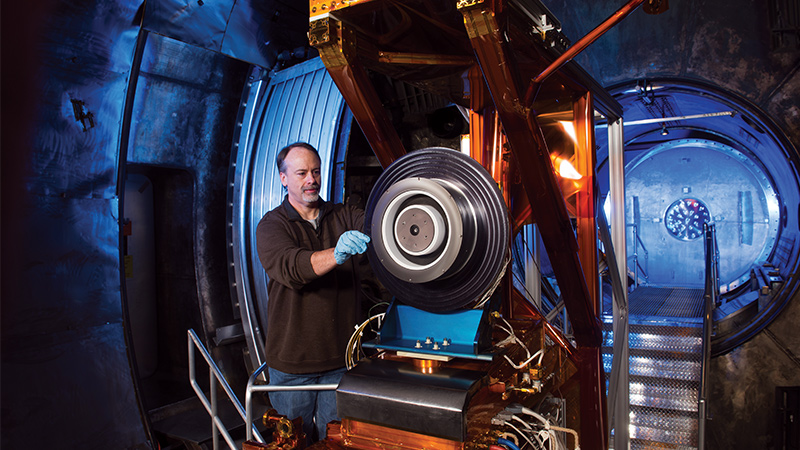Stay Up to Date
Submit your email address to receive the latest industry and Aerospace America news.
Aerojet Rocketdyne is scheduled to deliver plans to NASA in August for a solar electric propulsion thruster that could propel the planned moon-orbiting Deep Space Gateway as a precursor to a human mission to Mars.
NASA hired Aerojet Rocketdyne to build the Advanced Electric Propulsion System thruster by 2019 for future NASA space missions, and the technology might have applications for commercial satellites as well. With 13 kilowatts of power available for propulsion, the new thruster would more than double both the power available and the corresponding thrust generated by the current state-of-the-art solar electric propulsion thrusters, which operate at 3 to 5 kilowatts and are becoming routine for commercial communications satellites.
NASA also wants the thruster to deliver a higher specific impulse — for better fuel efficiency — than current solar electric propulsion thrusters and a longer lifespan: 1,700 on/off cycles over a mission lasting at least eight years. Aerojet Rocketdyne will present plans for its preliminary design review in August, then lock in the plans for a critical design review in 2018 before final testing and qualification of the thruster in 2019.
NASA envisions combining three to five of the 13-kilowatt thrusters to propel a spacecraft for humans circling the moon as practice before a human mission to Mars, says David Manzella, chief engineer for NASA’s Solar Electric Propulsion Technology Demonstration Mission Project.
NASA had planned to incorporate the technology in its Asteroid Redirect Mission, but that mission was canceled in President Donald Trump’s proposed 2018 budget. NASA’s first job for the new thrusters would be propelling the Deep Space Gateway spacecraft sometime around 2022. Orion crew spacecraft would dock with the gateway, which would provide a habitat for a crew of four people for up to 42 days.
“Raising the thrust level like we’re doing allows us to get to places more quickly,” Manzella says. “And that’s basically what was necessary to allow solar electric propulsion to be useful for human exploration. You can’t put a crew on a thing that’s going to take eight years to get from Earth to Mars. You have to make the power high enough so that you can do these transfers more quickly.”
The Mars mission is going to need solar electric propulsion because the mass of chemical propellant needed for a deep space mission would overwhelm, says Joe Cassady, Aerojet Rocketdyne’s executive director of space. “The reason that it’s such a driver for us in the Mars mission is: It saves a tremendous amount of money, just not having to launch that propellant off the planet, to do those transfers to Mars.”
Aerojet Rocketdyne is basing its design on the Hall Effect Rocket with Magnetic Shielding, or HERMeS — a 12.5 kilowatt prototype solar electric thruster developed by NASA, Cassady says.
Editor’s note: In the photo at top, NASA Glenn Research engineer Peter Peterson prepares the Hall Effect Rocket with Magnetic Shielding, or HERMeS, for ground testing in a vacuum chamber that simulates the environment in space.
About Keith Button
Keith has written for C4ISR Journal and Hedge Fund Alert, where he broke news of the 2007 Bear Stearns hedge fund blowup that kicked off the global credit crisis. He is based in New York.
Related Posts
Stay Up to Date
Submit your email address to receive the latest industry and Aerospace America news.




